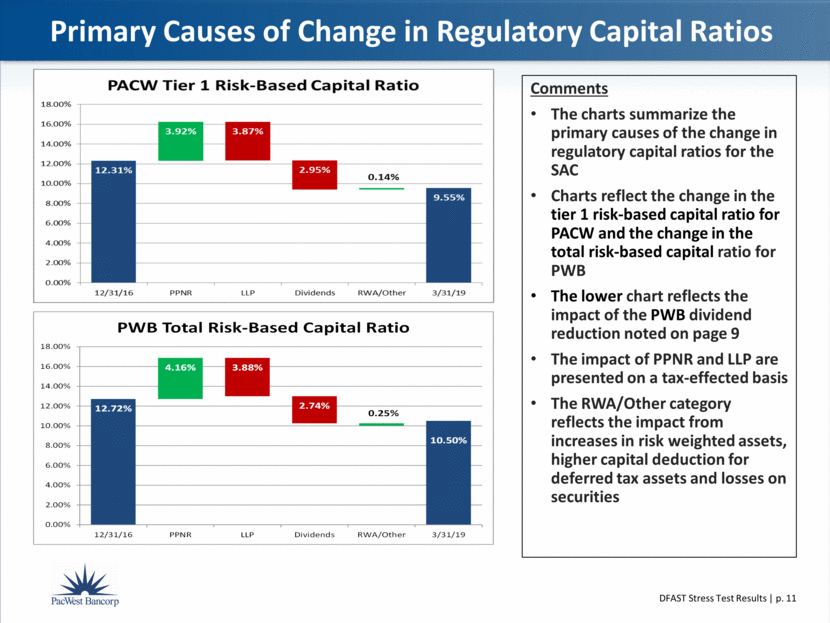- PACW Dashboard
- Financials
- Filings
-
Holdings
- Transcripts
-
ETFs
- Insider
- Institutional
- Shorts
-
425 Filing
Pacwest Bancorp (PACW) 425Business combination disclosure
Filed: 17 Oct 17, 12:00am
Forward Looking Statements The presentation includes forward looking statements within the meaning of the “Safe-Harbor” provisions of the Private Securities Litigation Reform Act of 1995, which are necessarily subject to risk and uncertainty. Actual results could differ materially due to actual economic factors and various risks, including those set forth from time to time in our filings with the Securities and Exchange Commission (“SEC”). This disclosure contains forward looking statements relating to our Dodd-Frank Act stress test results, including projections of our financial condition and results, under the hypothetical Severely Adverse scenario prescribed to us by our regulators. The projections contained within are not intended to reflect our expectations about future economic conditions or our forecasted results. The Company’s future financial condition and results of operations will be influenced by the actual economic and financial conditions prevailing at such future dates as well as various other factors which are described in reports filed by the Company with the SEC. Such reports are available on the Company’s website or through the SEC’s website at www.sec.gov. You should not place undue reliance on forward-looking statements and we undertake no obligation, except as required by law, to update any such statements.
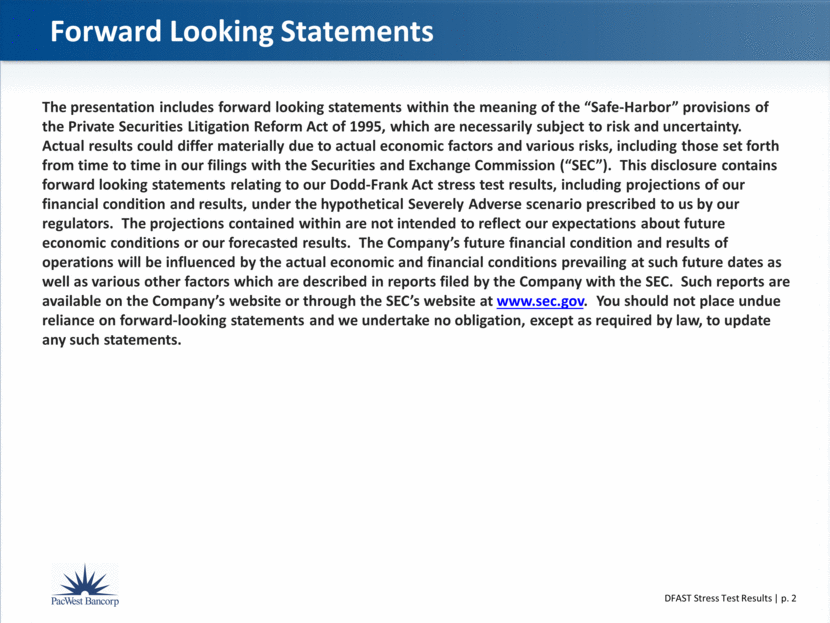
Company Overview PacWest Bancorp (“PACW” or the “Company”) is a bank holding company based in Beverly Hills, California with $22.2 billion of assets at September 30, 2017 Pacific Western Bank (“PWB”) is the principal operating subsidiary and sole banking subsidiary of PACW Through PWB, the Company Provides commercial banking services, including real estate, construction, and commercial loans and leases, and comprehensive deposit and treasury management services to small and middle-market businesses nationwide Operates 74 full-service branches located throughout California, one branch located in Durham, North Carolina and loan production offices located in cities across the country Provides investment advisory and asset management services to clients through Square 1 Asset Management, Inc., a wholly-owned subsidiary of PWB and SEC-registered investment adviser
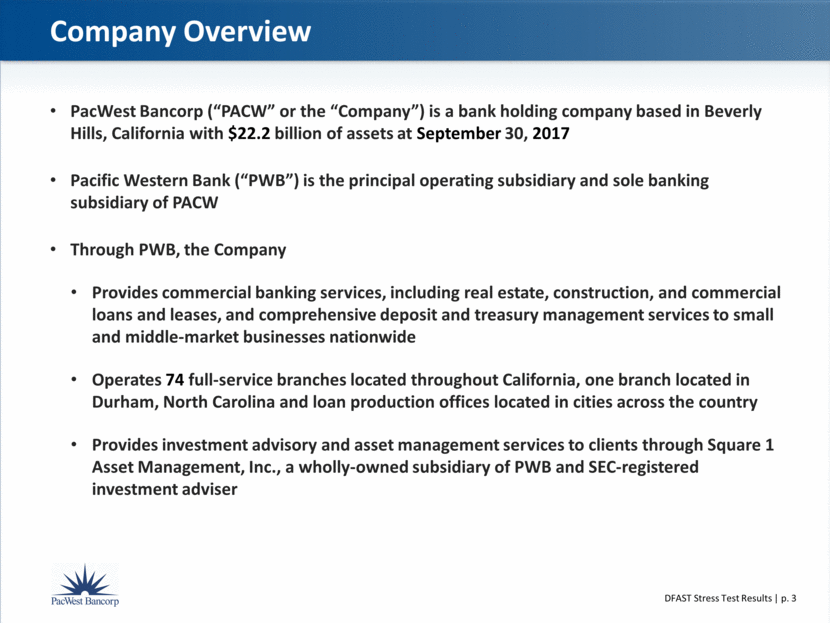
Dodd-Frank Act The Dodd-Frank Wall Street Reform and Consumer Protection Act and related banking regulations require banks with total consolidated assets of greater than $10 billion to conduct annual stress tests (“DFAST”) Under DFAST, banking organizations are required to prepare financial statement and capital ratio projections over a nine quarter planning period using hypothetical Baseline, Adverse and Severely Adverse economic scenarios provided by the regulators (“Supervisory Scenarios”) The 2017 stress test projection period begins with the Company’s balance sheet at December 31, 2016 and includes a forecast of nine quarters of operating results ending March 31, 2019 More information regarding the 2017 Supervisory Scenarios and the DFAST rules are available on the Federal Reserve website at http://www.federalreserve.gov The Supervisory Scenarios do not represent forecasts of anticipated economic conditions, and stress tests do not represent forecasts of expected results The DFAST information is used by the regulatory agencies to form supervisory assessments of how effectively banking organizations conduct capital planning, identify and measure risk, and assess capital adequacy The DFAST rules require that PACW and PWB publicly disclose a summary of the following A description of the risks and methodologies used in the stress test The results of the hypothetical Severely Adverse Case The most significant causes of the change in regulatory capital ratios in the Severely Adverse Scenario
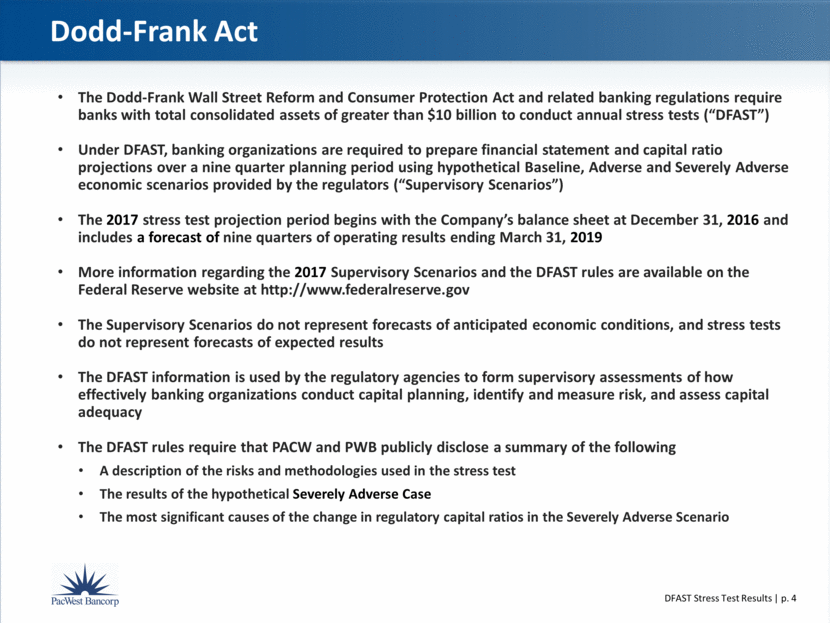
Material Risks Included in the Stress Test Below is a summary of the material risks included in the stress test Credit Risk The risk to earnings and capital resulting from the failure of a borrower or a counterparty to meet its contractual obligations to the Company The impact to earnings and capital occurs through increased loan loss provision and, to a lesser extent, losses on securities Interest Rate Risk The risk to earnings and capital resulting from changes in interest rates The impact to earnings and capital occurs from changes in interest income and interest expense Liquidity Risk / Price Risk The risk to earnings and capital resulting from the Company’s inability to meet its obligations as they become due, or to manage unexpected changes in access to or the cost of funding sources The impact to earnings and capital occurs through losses the Company could incur in the course of liquidating loans or securities, or from higher borrowing costs on alternative funding sources
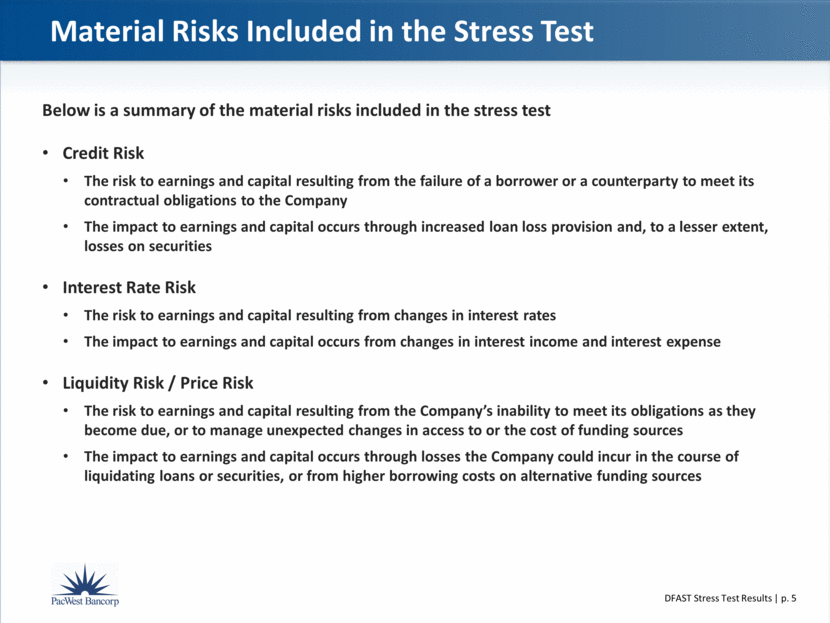
Supervisory Severely Adverse Case Category Variable Supervisory Assumptions Economy Real GDP (annualized) 5 quarters of negative growth; low of -7.5%; rises to 3.0% by the end of the 9-quarter planning period Unemployment Rises to a peak of 10.0% towards the end of the 9-quarter planning period Interest Rates Prime Rate Declines from 3.50% to 3.20% within four quarters and remains at that level for the remaining planning period 3 Month Treasury Declines from 0.40% to 0.10% within one quarter and remains at that level for the remaining planning period 10 Year Treasury Declines from 2.20% to 0.80% within one quarter, and then rises to 1.50% by the end of the 9-quarter planning period Asset Prices Commercial Real Estate Price Index Declines each quarter; the index at the end of the 9-quarter planning period equals 65% of the starting index Dow Jones Total Stock Market Index Declines to a low of 50% of the starting index, and rises to 73% of the starting index by the end of the 9-quarter planning period The Severely Adverse Case (“SAC”) is characterized by a severe global recession that is accompanied by a period of heightened stress in corporate loan markets and commercial real estate markets Below is a summary of the behavior of key economic and market indices included in the SAC
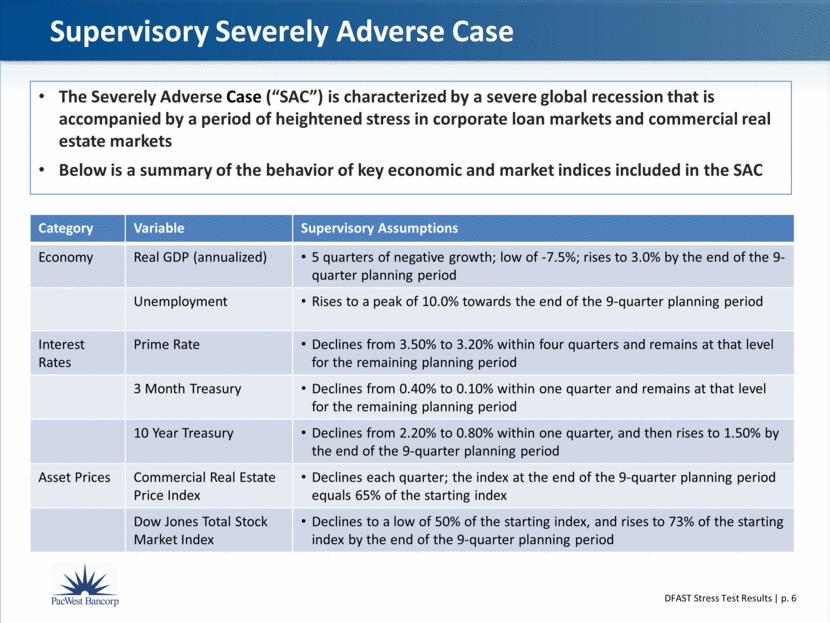
Methodologies Used in the Stress Test Category Methodology Loan Charge-offs Charge-off rates for the larger loan segments were derived using regression models developed using historical charge-off data for the Company and peer banks selected for each loan segment; model-derived results were adjusted in some cases based on management judgment Charge-off rates for smaller loan segments were projected based on peer bank loss history Allowance for Loan and Lease Losses (“ALLL”); Loan Loss Provision (“LLP”) The ALLL at the end of each quarter was estimated using a model that combines outputs from the charge-off models, historical probability of default (PD) and loss given default (LGD) rates by loan segment, and adjustments to the PD and LGD rates during the course of the scenario; LLP is derived from changes in the ALLL balances Loan, Security and Deposit Balances Loan balance growth rates for the larger loan segments were derived using regression models developed using historical loan balances for peer banks selected for each loan segment; model-derived results were adjusted in some cases based on management judgment Loan balances for smaller loan segments were projected based on management judgment Deposit balances were based on a regression model developed using historical data for the Company and a group of peer banks Security balances were based on funding and liquidity needs driven by projected loan and deposit balances Pre Provision Net Revenue (“PPNR”); Losses on Securities PPNR equals net interest income plus non interest income less non interest expense; PPNR excludes LLP and losses on securities PPNR is estimated by combining assumptions from the loan and deposit balance models above, forward curves from the regulatory scenario, security yields based on historical market levels and assumptions for loan spreads, non interest income and non interest expense levels based on Company history and management judgment Losses on securities were estimated using a combination of regression models, historical market data and management judgment Regulatory Capital, Risk Weighted Assets (“RWA”), Adjusted Assets (“AA”) Regulatory capital, RWA and AA were derived using outputs from the models above and applying the Basel III rules The key methodologies used to prepare the stress test are summarized below The stress test assumptions and results were reviewed and approved by management and the Board

Stress Test Results – SAC Income Statement/Loss Rate PACW $MM Cumulative 9-Qtr Amount % Avg Assets Pre Provision Net Revenue $ 1,214 5.29% Loan Loss Provision 1,199 5.22% Losses on Securities 7 0.03% Pretax Income 8 0.04% Net Income 28 0.12% PWB $MM Cumulative 9-Qtr Amount % Avg Assets Pre Provision Net Revenue $ 1,285 5.59% Loan Loss Provision 1,199 5.21% Losses on Securities 6 0.03% Pretax Income 80 0.35% Net Income 75 0.32% Comments First two tables summarize key income statement line items on a cumulative basis during the 9-quarter planning period of the SAC Results are shown separately for PACW and PWB Column for “% of average assets” computed by dividing the cumulative dollar amounts by the average assets for the 9-quarter planning period; ratios are cumulative, not annualized Bottom table summarizes the cumulative net charge-offs and loss rates during the 9-quarter planning period of the SAC Cumulative loss rate computed by dividing cumulative net charge-offs by average loan balances for the 9-quarter planning period; ratios are cumulative, not annualized $MM Cumulative 9-Qtr NCOs Cumulative Loss Rate Cumulative Loan Losses $ 974 6.31%
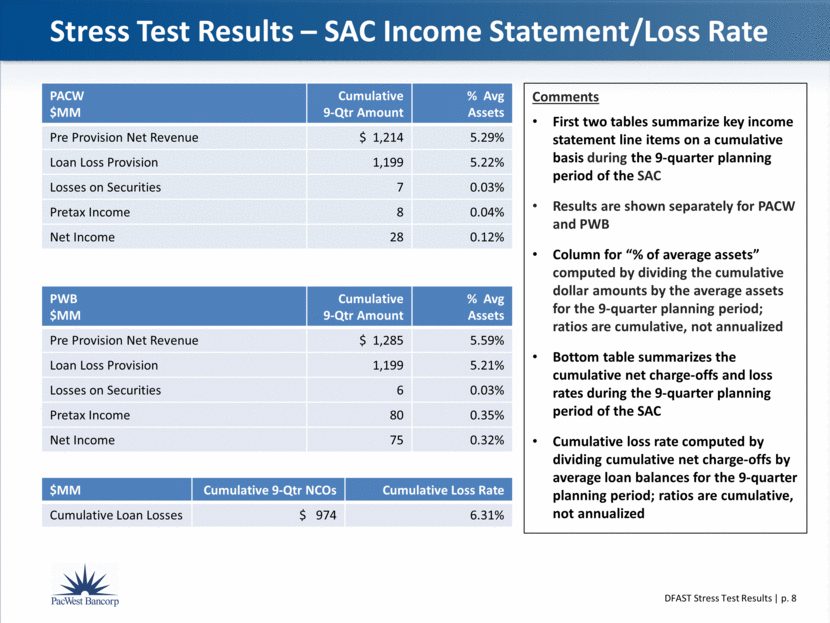
Stress Test Results – SAC Capital Actions In order to maintain capital ratios at levels greater than or equal to the regulatory minimum plus the fully-phased-in capital conservation buffer of 2.50% No dividend reductions are necessary at PACW Dividend reductions are necessary at PWB No capital redemptions or repurchases are assumed in the scenario PACW cumulative dividends in the SAC -- $548 million PWB cumulative dividends in the SAC Cumulative dividends assuming no reduction -- $583 million Cumulative dividends assumed in the stress test -- $508 million Cumulative dividend reduction is equal to $75 million, or 13%
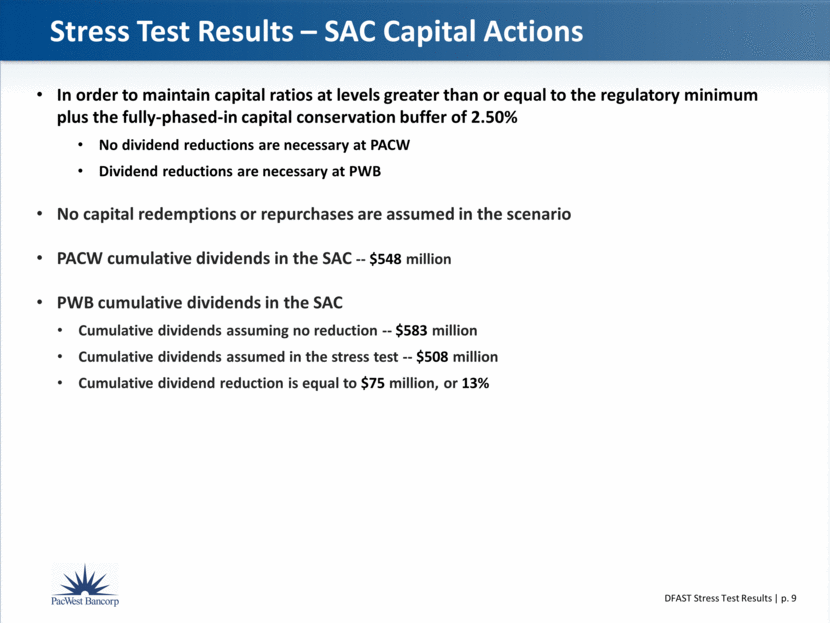
Stress Test Results – SAC Capital Ratios PACW Actual Q4 2016 Q1 2019 Stress Low Basel III Min + CCB Basel III Min Common Equity Tier 1 Ratio 12.31% 9.55% 9.55% 7.00% 4.50% Tier 1 Risk-Based Capital Ratio 12.31% 9.55% 9.55% 8.50% 6.00% Total Risk-Based Capital Ratio 15.56% 13.12% 13.12% 10.50% 8.00% Tier 1 Leverage Ratio 11.91% 8.44% 8.44% NA 4.00% Risk Weighted Assets ($MM) $18,569 $19,069 NA NA NA Comments The charts to the left summarize regulatory capital ratios for the start, end and low point of the SAC Results are shown separately for PACW and PWB Basel III Min is the minimum capital ratio under the Basel III rules CCB equals the fully-phased-in capital conservation buffer of 2.50% Regulatory “well capitalized” thresholds are 0.50% less than the Basel III Min + CCB level, except the “well capitalized” Tier 1 Leverage threshold is 5.00% (versus the 4.00% minimum level; there is no CCB for the Tier 1 Leverage ratio) PWB Actual Q4 2016 Q1 2019 Stress Low Basel III Min + CCB Basel III Min Common Equity Tier 1 Ratio 11.78% 9.24% 9.24% 7.00% 4.50% Tier 1 Risk-Based Capital Ratio 11.78% 9.24% 9.24% 8.50% 6.00% Total Risk-Based Capital Ratio 12.72% 10.50% 10.50% 10.50% 8.00% Tier 1 Leverage Ratio 11.40% 8.23% 8.23% NA 4.00% Risk Weighted Assets ($MM) $18,547 $19,241 NA NA NA
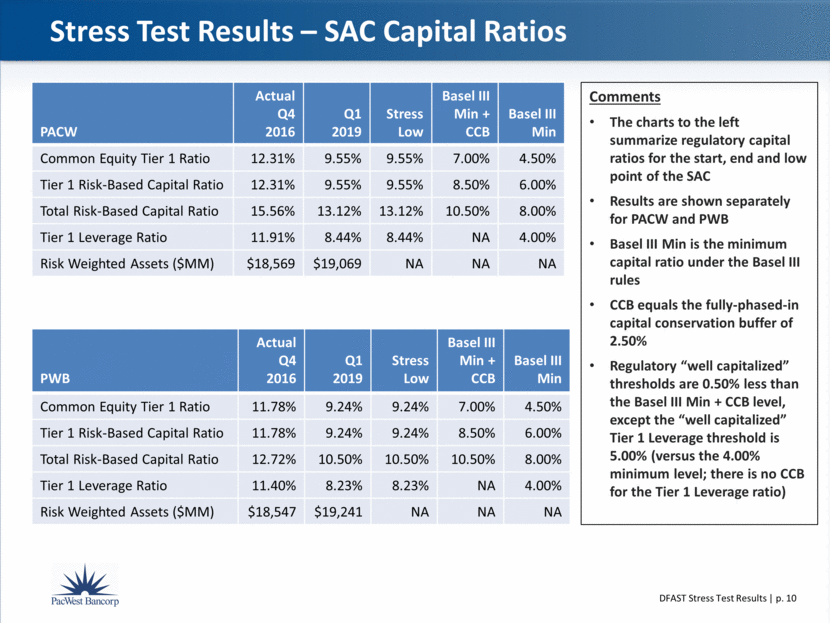
Primary Causes of Change in Regulatory Capital Ratios Comments The charts summarize the primary causes of the change in regulatory capital ratios for the SAC Charts reflect the change in the tier 1 risk-based capital ratio for PACW and the change in the total risk-based capital ratio for PWB The lower chart reflects the impact of the PWB dividend reduction noted on page 9 The impact of PPNR and LLP are presented on a tax-effected basis The RWA/Other category reflects the impact from increases in risk weighted assets, higher capital deduction for deferred tax assets and losses on securities 12.72% 4.16% 3.88% 2.74% 0.25% 10.50% 0.00% 2.00% 4.00% 6.00% 8.00% 10.00% 12.00% 14.00% 16.00% 18.00% 12/31/16 PPNR LLP Dividends RWA/Other 3/31/19 PWB Total Risk - Based Capital Ratio
